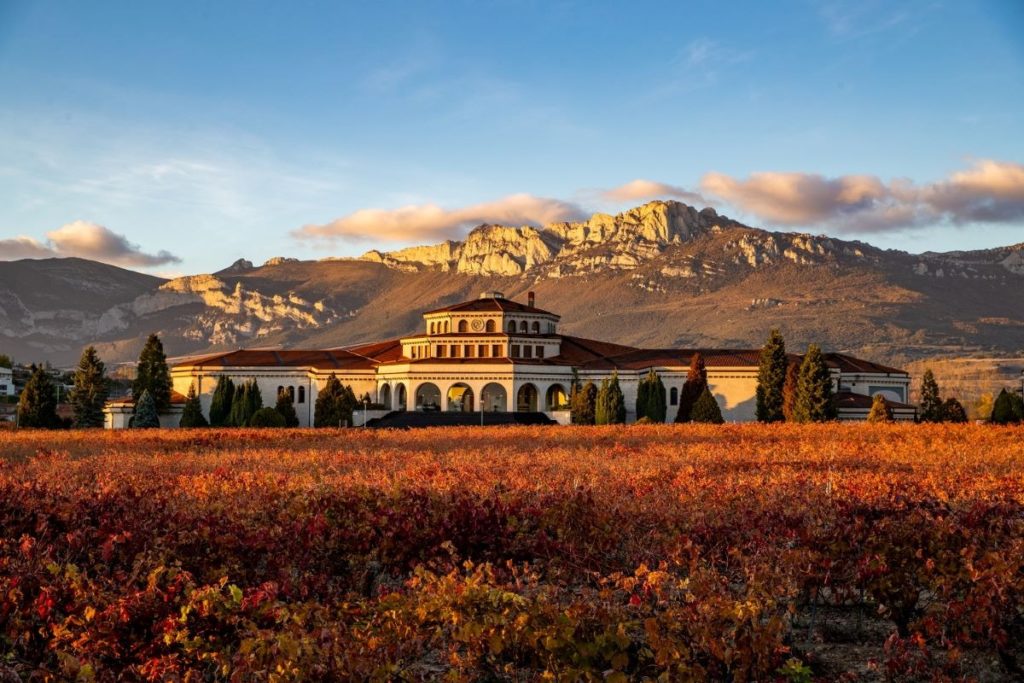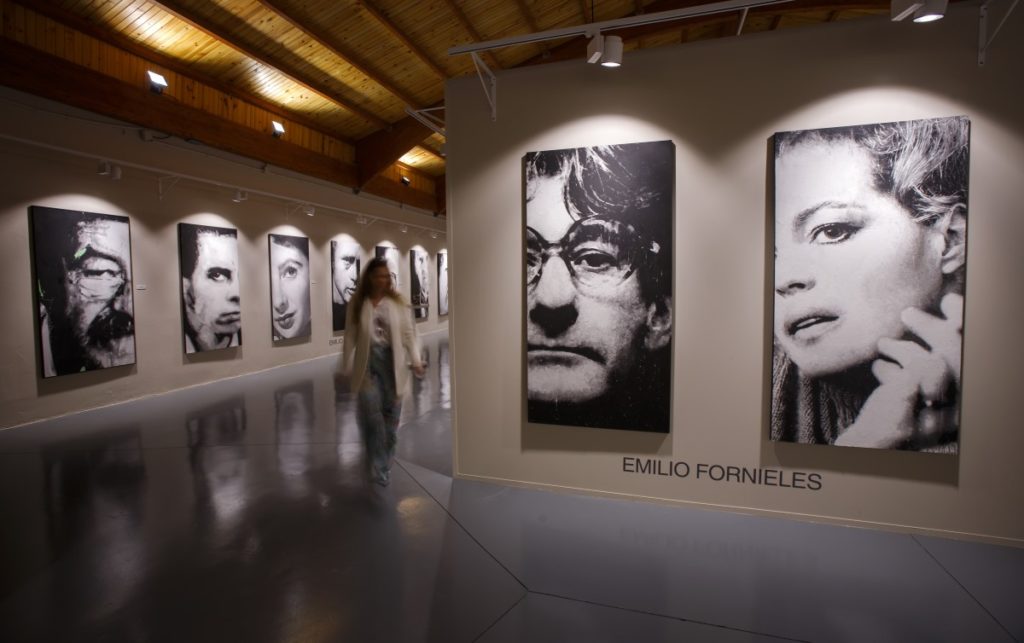High above the medieval town of Laguardia, where vineyards cascade down ancient hillsides like emerald tapestries, stands a winery that has redefined what it means to experience wine culture. Bodegas Campillo, the 2025 Best Of Wine Tourism Award winner in the Art & Culture category, represents far more than exceptional winemaking—it embodies a vision where architectural brilliance, contemporary art, and centuries-old viticultural traditions converge in remarkable harmony.
Since its inauguration in 1990, Campillo has held the distinction of being the first winery designed by an architect as a unique project, where the beauty of its architectural forms gets together with the best technical and functional requirements for the production and ageing of wine. Built in the style of a château at the heart of a 50-hectare estate, the winery’s design philosophy was revolutionary for its time—and remains compelling today.
The building itself serves as the first exhibit in what has become an ongoing dialogue between wine and art. Clean lines and natural materials create spaces that breathe with the same organic rhythm as the fermentation process within. Light pours through carefully positioned windows, illuminating the barrel rooms where wines age in contemplative silence. This isn’t mere functionality dressed up as aesthetics; it’s architecture that enhances every aspect of the winemaking process while creating an environment where visitors can fully immerse themselves in the sensory experience of wine culture.

A Gallery Reborn
The winery’s commitment to art extends far beyond its architectural bones. Campillo Creativo by Bodegas Campillo in Laguardia, Rioja Alavesa, involves the establishment of a substantial art exhibition area, transforming the winery into a dynamic cultural space that hosts rotating exhibitions featuring prominent Spanish artists. These aren’t token gestures toward culture—they’re serious artistic endeavors that attract visitors who might never have considered stepping foot in a winery.
Walking through these exhibition spaces, visitors encounter contemporary works that respond to and complement the ancient craft of winemaking. The juxtaposition is striking: modern sculptures casting shadows over centuries-old winemaking tools, paintings that capture the essence of harvest season hanging adjacent to tanks where this year’s vintage slowly transforms. It’s a conversation across time, mediums, and sensibilities that elevates both the art and the wine.
The Martinez Zabala Gallery within the winery showcases this commitment to cultural excellence, offering visitors the opportunity to experience wine within a broader artistic context. Here, the boundaries between winemaker and curator blur, creating an environment where every element—from the carefully selected artworks to the wines themselves—contributes to a cohesive aesthetic experience.
Beyond the Cellar Door
The recognition from the Great Wine Capitals Global Network’s Best Of Wine Tourism Awards, which celebrate innovation and excellence in wine tourism throughout the greatest wine regions in the world, validates what visitors have long understood: Campillo offers something genuinely different. The award in the Art & Culture category specifically acknowledges how the winery has successfully integrated cultural programming with traditional wine tourism, creating experiences that appeal to diverse audiences and interests.
This achievement reflects the broader mission of the Best Of Wine Tourism Awards, honoring wine tourism initiatives capable of combining tradition with innovation, authenticity with creativity, and sustainability with quality. Campillo exemplifies these values through its multifaceted approach to hospitality, where guests might begin their visit with a private tour of current exhibitions before moving into the vineyards for a terroir-focused tasting, then concluding with a sunset dinner paired with wines from their private cellar selection.
The winery’s programming extends throughout the year, adapting to seasons and artistic themes. Spring might bring plein air painting workshops among blooming vines, while autumn harvest celebrations include live music performances in the barrel rooms. Winter offers intimate art openings with wine pairings designed specifically to complement featured artworks. Each season brings its own cultural calendar, ensuring that repeat visitors always encounter something new.

The Laguardia Connection
Campillo’s commitment to art and culture resonates perfectly with its location in Laguardia, itself a masterpiece of medieval architecture. The town, perched on its hilltop like a crown jewel, provides the perfect backdrop for a winery that takes culture as seriously as viticulture. Founded in the 10th century as a defensive outpost for the Kingdom of Navarre, Laguardia has preserved its medieval character while embracing contemporary wine culture.
The narrow cobblestone streets that wind between ancient stone buildings lead inevitably to the surrounding vineyards where Campillo’s grapes grow. This seamless integration of historical architecture, contemporary winemaking, and modern artistic expression creates a sense of place that feels both timeless and thoroughly modern. Visitors often describe the experience as traveling through layers of history while remaining firmly grounded in the present moment.
The winery’s location within this cultural landscape isn’t coincidental—it’s integral to understanding Campillo’s artistic mission. The same aesthetic sensibilities that preserve Laguardia’s architectural heritage inform the winery’s approach to both winemaking and cultural programming. There’s a respect for tradition balanced with enthusiasm for innovation, a combination that defines both the town and the winery within it.
Redefining Wine Tourism
What sets Campillo apart from other cultural initiatives in wine country is its refusal to treat art as an afterthought or marketing tool. Instead, cultural programming is woven into the fabric of every visitor experience. The Maestros de la Esencia –Essence Masters philosophy that guides the winery extends beyond winemaking to encompass every aspect of hospitality and artistic curation.
This integration creates opportunities for meaningful engagement that extend far beyond traditional wine tastings. Visitors might find themselves in conversation with featured artists during exhibition openings, or participating in workshops where they create their own artistic responses to wine and place. These experiences generate lasting connections not just to the wines, but to the broader cultural context that shapes them.
The winery’s various spaces—from the 746-square-meter main hall to intimate 15-person meeting rooms—provide flexibility for different types of cultural programming. Corporate groups might engage in team-building exercises that combine artistic collaboration with wine education. Private collectors could arrange exclusive viewings of both the art collection and rare wine library. Each experience is crafted to reflect the sophisticated integration of culture and wine that defines Campillo’s approach.
The Best Of Wine Tourism recognition serves as both validation and inspiration for Campillo’s continued evolution as a cultural destination. The awards push everyone in the wine tourism industry to continually improve and to aim high, and Campillo’s response has been to deepen its commitment to artistic excellence while maintaining the highest standards of winemaking and hospitality.

As wine tourism continues to evolve, Bodegas Campillo stands as a compelling example of what’s possible when vision, artistry, and craftsmanship align. This isn’t wine tourism as mere recreation—it’s cultural engagement that happens to center around wine, creating experiences that resonate long after the last glass is emptied and the final artwork is viewed. In a world where authentic cultural experiences become increasingly rare, Campillo offers something genuinely transformative: a place where art and wine don’t just coexist, but collaborate in creating memories that endure.
Visit Bodegas Campillo’s web for reservations and more information.
Text by Liz Aldayturriaga
Photo credits: Bodegas Campillo
Learn more about Bilbao-Rioja Great Wine Capitals